CHEVROLET CAMARO 1994 4.G Owners Manual
Manufacturer: CHEVROLET, Model Year: 1994, Model line: CAMARO, Model: CHEVROLET CAMARO 1994 4.GPages: 292, PDF Size: 15.35 MB
Page 241 of 292
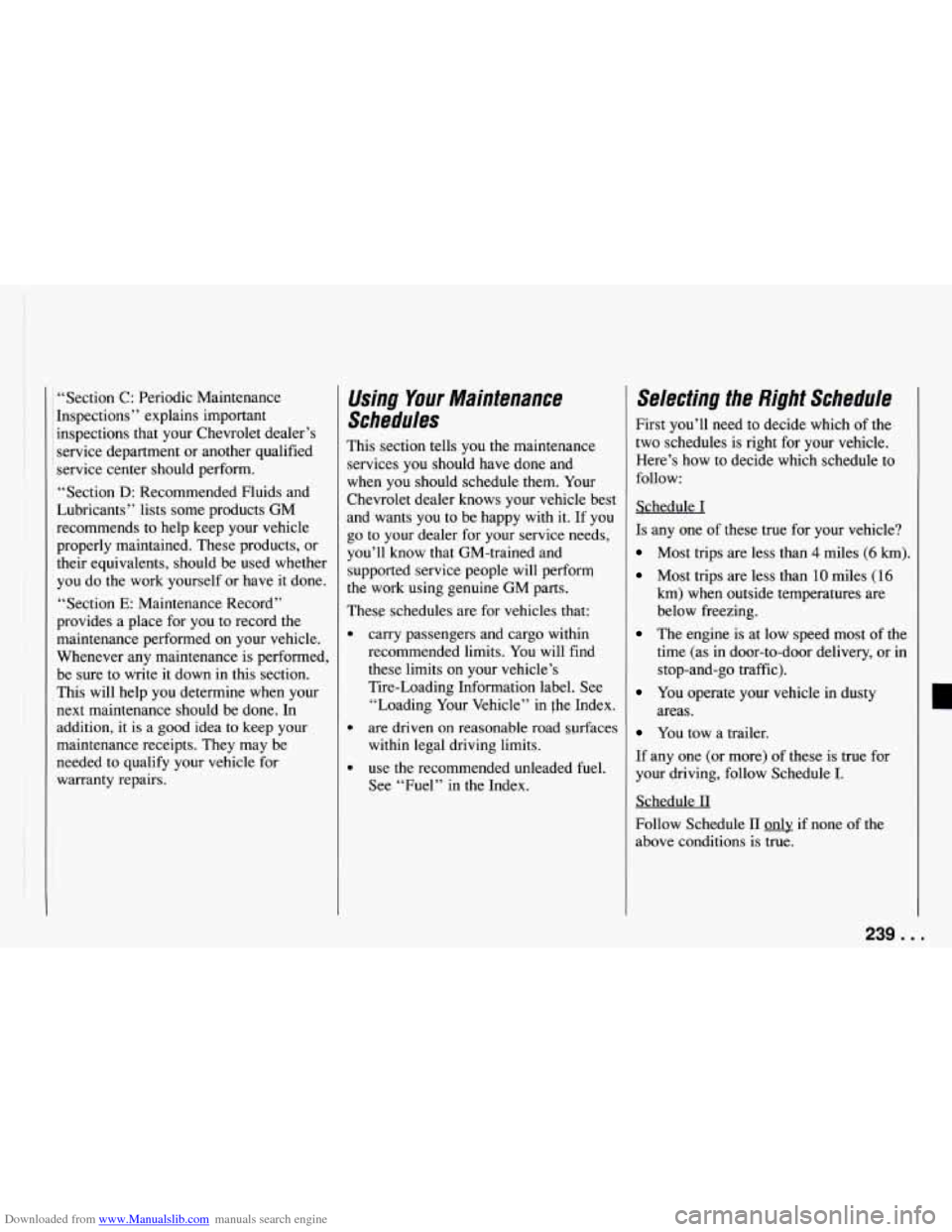
Downloaded from www.Manualslib.com manuals search engine “Section C: Periodic Maintenance
: Inspections” explains important
inspections that your Chevrolet dealer’s
service department or another qualified
service center should perform.
“Section
D: Recommended Fluids and
Lubricants” lists some products GM
recommends to help keep your vehicle
properly maintained. These products, or their equivalents, should be used whether
you do the work yourself or have it done.
“Section
E: Maintenance Record”
provides a place for you to record the
maintenance performed on your vehicle.
Whenever any maintenance is performed,
be sure to write it down in this section.
This will help you determine when your
next maintenance should be done. In
addition, it is a good idea
to keep your
maintenance receipts. They may be
needed to qualify your vehicle for
warranty repairs.
Using Your Maintenance
Schedules
This section tells you the maintenance
services you should have done and
when you should schedule them. Your
Chevrolet dealer knows your vehicle best
and wants you to be happy with it. If you
go to your dealer for your service needs,
you’ll know that GM-trained and
supported service people will perform
the work using genuine GM parts.
These schedules are for vehicles that:
carry passengers and cargo within
recommended limits.
You will find
these limits on your vehicle’s
Tire-Loading Information label. See
“Loading Your Vehicle” in the Index.
are driven on reasonable road pprfaces
within legal driving limits.
use
the recommended unleaded fuel.
See “Fuel” in the Index.
Selecting the Right Schedule
First you’ll need to decide which of the
two schedules is right for your vehicle.
Here’s how to decide which schedule to
follow:
Schedule
I
Is any one of these true for your vehicle?
Most trips are less than 4 miles (6 km).
Most trips are less than 10 miles (16
km) when outside temperatures are
below freezing.
The engine is at low speed most of the
time (as in door-to-door delivery, or in
stop-and-go traffic).
You operate your vehicle in dusty
You tow a trailer.
If any one (or more) of these is true for
your driving, follow Schedule
I.
Schedule 11
Follow Schedule I1 on& if none of the
above conditions is true.
areas.
239.. .
Page 242 of 292
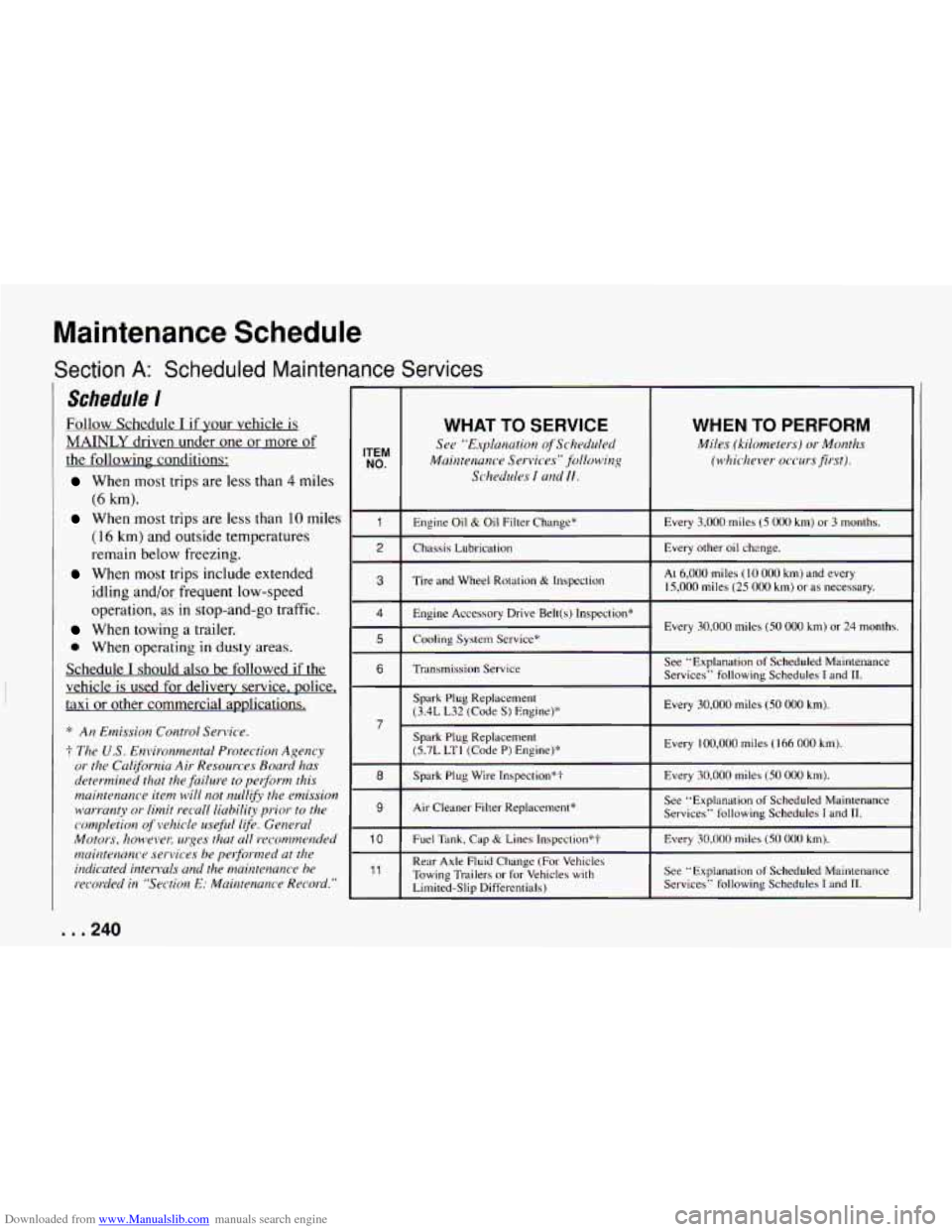
Downloaded from www.Manualslib.com manuals search engine Maintenance Schedule
Section A: Scheduled Maintenance Services
Schedule 1
MAINLY driven under one or more of
the following conditions:
When most trips are less than 4 miles
(6 km).
When most trips are less than 10 miles
(16 km) and outside temperatures
remain below freezing.
When most trips include extended
idling and/or frequent low-speed
operation, as
in stop-and-go traffic.
When towing a trailer.
0 When operating in dusty areas.
Schedule
I should also be followed if the
vehicle is used for deliverv service, police,
taxi or other commercial applications.
* An Emission Control Service.
=t The U.S. En\sironmental Protection Agency
or the California Air Resources Board has
determined that the failure to pellform this
maintemnce item will not
nullifi. the emission
warranty
or limit recall liability prior to the
cvmpletion
cf vehicle usejul life. General
Motors, however, urges rhat all rec.*ornmended
maintenance services
he performed at the
indicated intervals and the maintenance be
recorded in “Section
E: Maintenance Record.”
ITEM NO.
-
1
2
3
4
5
6
7
8 -
9
10
11
WHAT TO SERVICE
See “E,rplanation of Scheduled
Maintenunce Servicae.s”
jullowing
Schedules I and 11.
Engine Oil & Oil Filter Change*
Chassis Lubrication
Tire and Wheel Rotation
& Inspection
Engine Accessory Drive Belt(s) Inspection*
Cooling System Service”
Transmission Service Spark Plug Replacement
(3.4L L32 (Code
S) Engine)*
Spark Plug Replacement
(5.7L LTI (Code P) Engine)*
Spark Plug Wire Inspection*+
Air Cleaner Filter Replacement*
Fuel Tank, Cap & Lines Inspection*?
Rear Axle Fluid Change
(For Vehicles
Towing Trailers
or for Vehicles with
Limited-Slip Differentials)
WHEN TO PERFORM
Miles (kilometers) or Months
(whichever occursfirst).
Every 3.000 miles (5 000 km) or 3 months.
Every other oil chenge.
At 6,000 miles (10 000 km) and every
15,000 miles (25 000 km) or as necessary.
Every 30,000 miles (50
000 km) or 24 months.
See “Explanation of Scheduled Maintenance
Services” following Schedules
I and 11.
Every 30,000 miles (50 000 km).
Every 100,000 miles ( 166 000 km).
Every 30,000 miles (50 000 km).
See “Explanation of Scheduled Maintenance
Services” following Schedules
I and II.
Every 30,000 miles (50 000 km).
See “Explanation of Scheduled Maintenance
Services” following Schedules
I and 11.
. . .240
Page 243 of 292
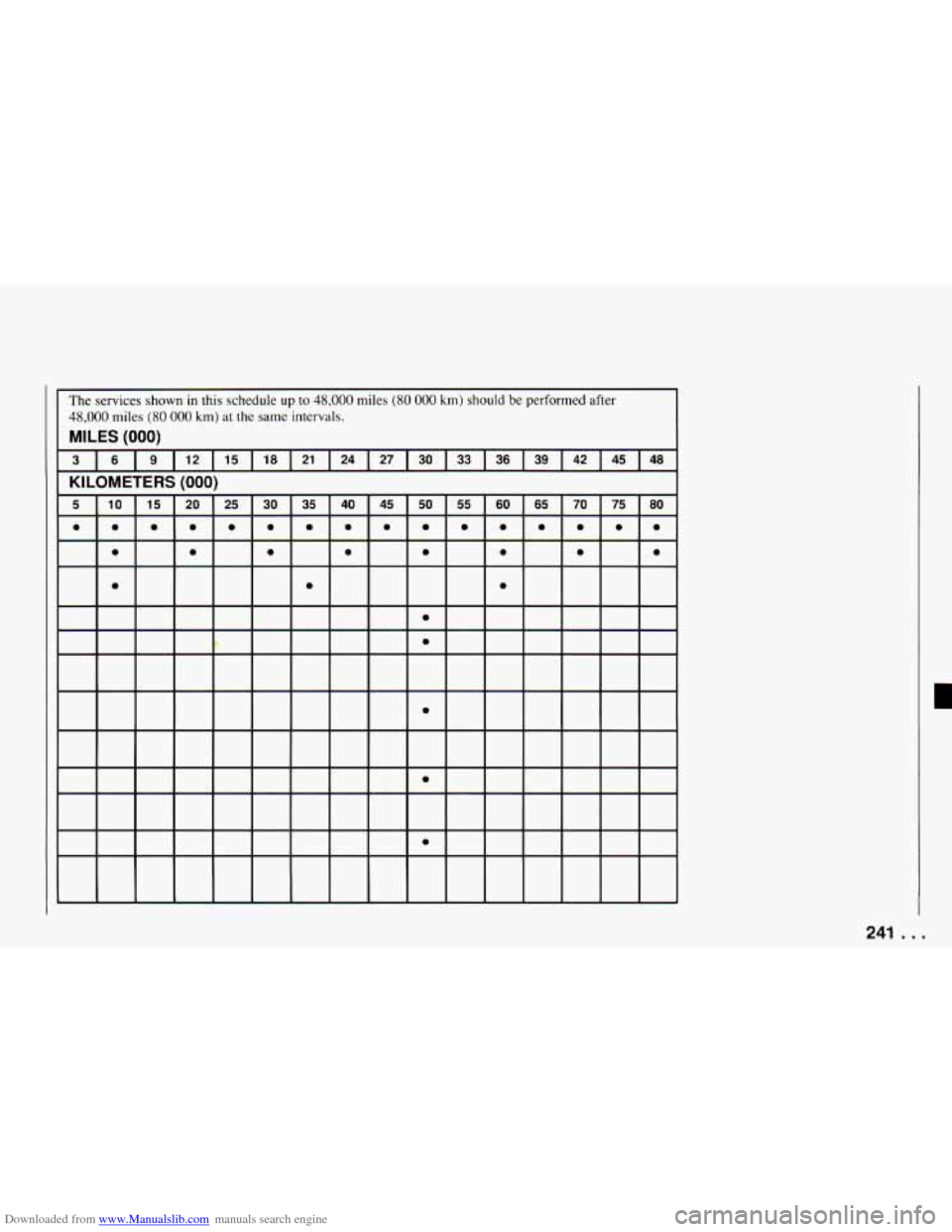
Downloaded from www.Manualslib.com manuals search engine The services shown in this schedule up to 48,000 miles (80 000 km) should be performed after
48,000 miles (80 000 km) at the same intervals.
MILES (000)
KILOMETERS (000)
3 16 19 112 115 I18 121 124 127 130 133 136 139 142 145 148
241 . . .
Page 244 of 292
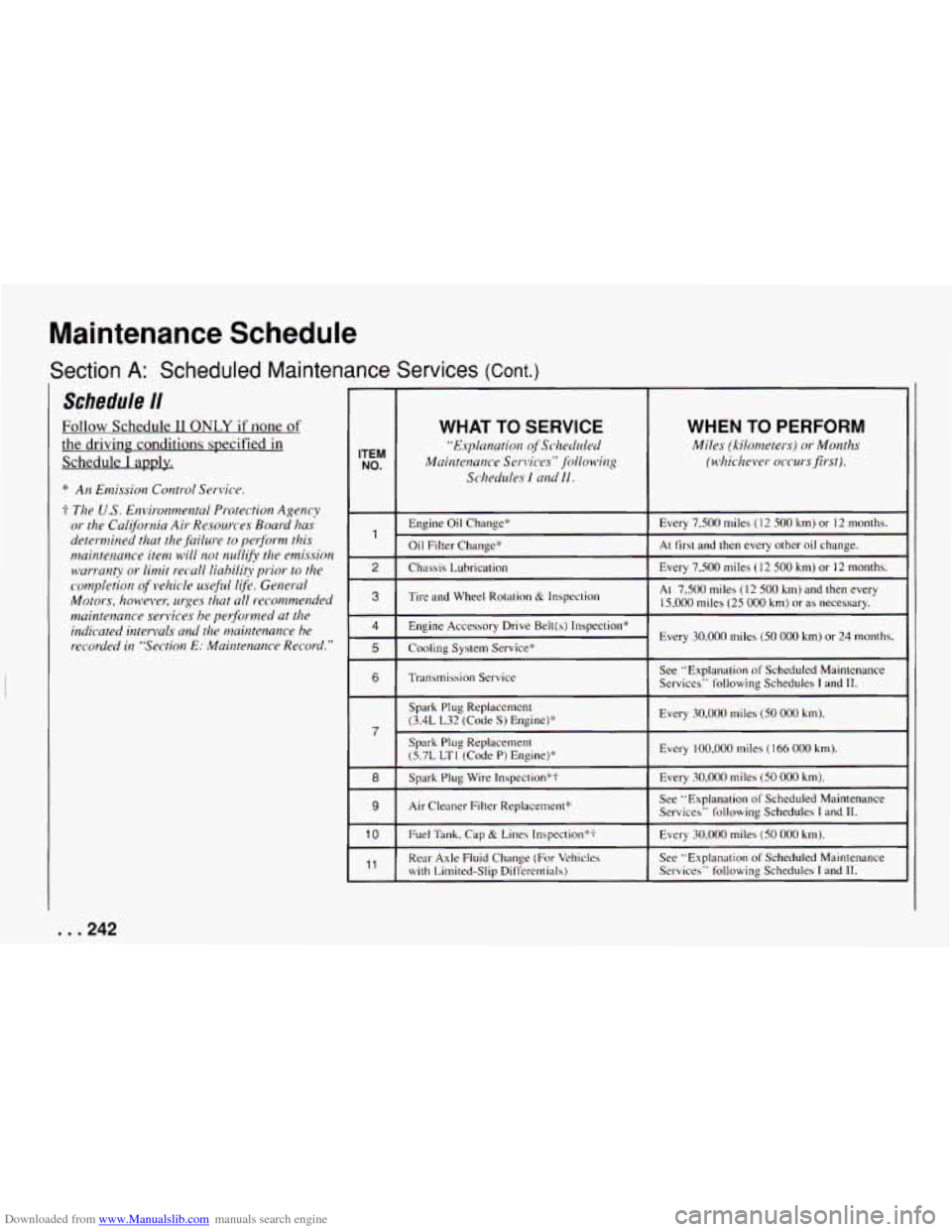
Downloaded from www.Manualslib.com manuals search engine Maintenance Schedule
Section A: Scheduled Maintenance Services (cont.)
Schedule 11
Follow Schedule I1 ONLY if none of
Jhe driving: conditions specified in
Schedule I appl~
* An Emission Contsol Ses\:icc.
il- The US. Envisonmental Psotection Agency
os the Calijosrtia Ais Resousces Bousd has
detesmined that
the failuse to pesfosm this
maintenance item will not nullib the emissiott
warsanty
or limit secall liability psios to the
completion of whicle useful life. Genesal
Motoss, howews, urges that all sccommended
maintenance semices
be pesformed at the
indicated inten*als and
rhe maintenance he
secorded in “Section E: Maintenance Record.”
ITEM NO.
1
-
2
3
-
4
5
6
-
-
-
7
-
8
9
-
10
11
WHAT TO SERVICE
“E.vplanutiol? c?fSd~eduleci
Mairztetzuncx~ Ses\.ic*es‘’ fhllolz*itlg
Schedules I Ulld !I.
Engine Oil Change”
Oil Filter Change*
Chassis Lubrication
Tire and Wheel Rotation
& Inspection
Engine Accessory Drive Belt(s) Inspection”
Cooling System Service”
Transmission Service Spark Plug Replacement
(3.4L L32 (Code S) Engine)”
Spark Plug Replacement
(5.7L LTI (Code P) Engine)*
Spark
Plug Wire Inspection”?
Air Cleaner Filter Replacement”
Fuel Tank, Cap & Lines Inspection’k+
Rear Axle Fluid Change (For Vehicles
with Limited-Slip Differentials) Every
7,500 miles (1 2 500
km) or 12 months.
At first and then every other oil chqnge.
Every 7,500 miles
( 12 SO0 km) or 12 months.
At 7.500 miles (1 2 SO0 km) and then every
15.000 miles
(25 000 km) or as necessary.
Every 30.000 miles
(50 000 km) or 24 months.
See “Explanation of Scheduled Maintenance
Services“ following Schedules
I and 11.
Every 30,000 miles (SO 000 km).
Every IOO.OOO miles ( 166 000 km).
Every 30,000 miles (50 000 km).
See “Explanation of Scheduled Maintenance
Services” following Schedules
I and 11.
Every 30.000 miles (50 000 km).
See “Explanation of Scheduled Maintenance
Services” lollowing Schedules
I and 11.
. . .242
Page 245 of 292
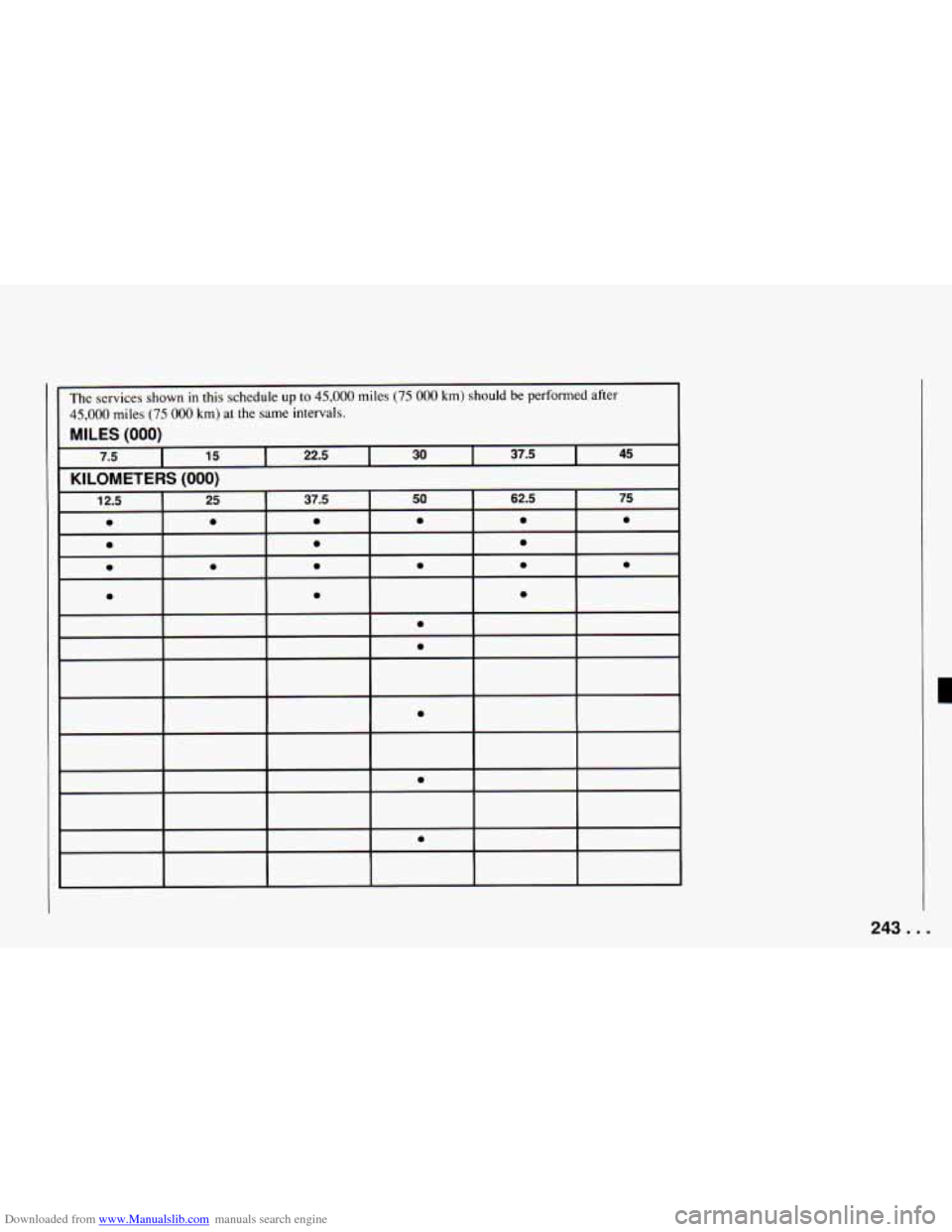
Downloaded from www.Manualslib.com manuals search engine I 45,000 miles (75 000 km) at the same intervals.
I MILES (000)
7.5 I I I I I 15
KILOMETERS (000)
22.5 30 37.5 45
I The services shown in this schedule up to 45,000 miles (75 000 km) should be performed after
243. . .
Page 246 of 292
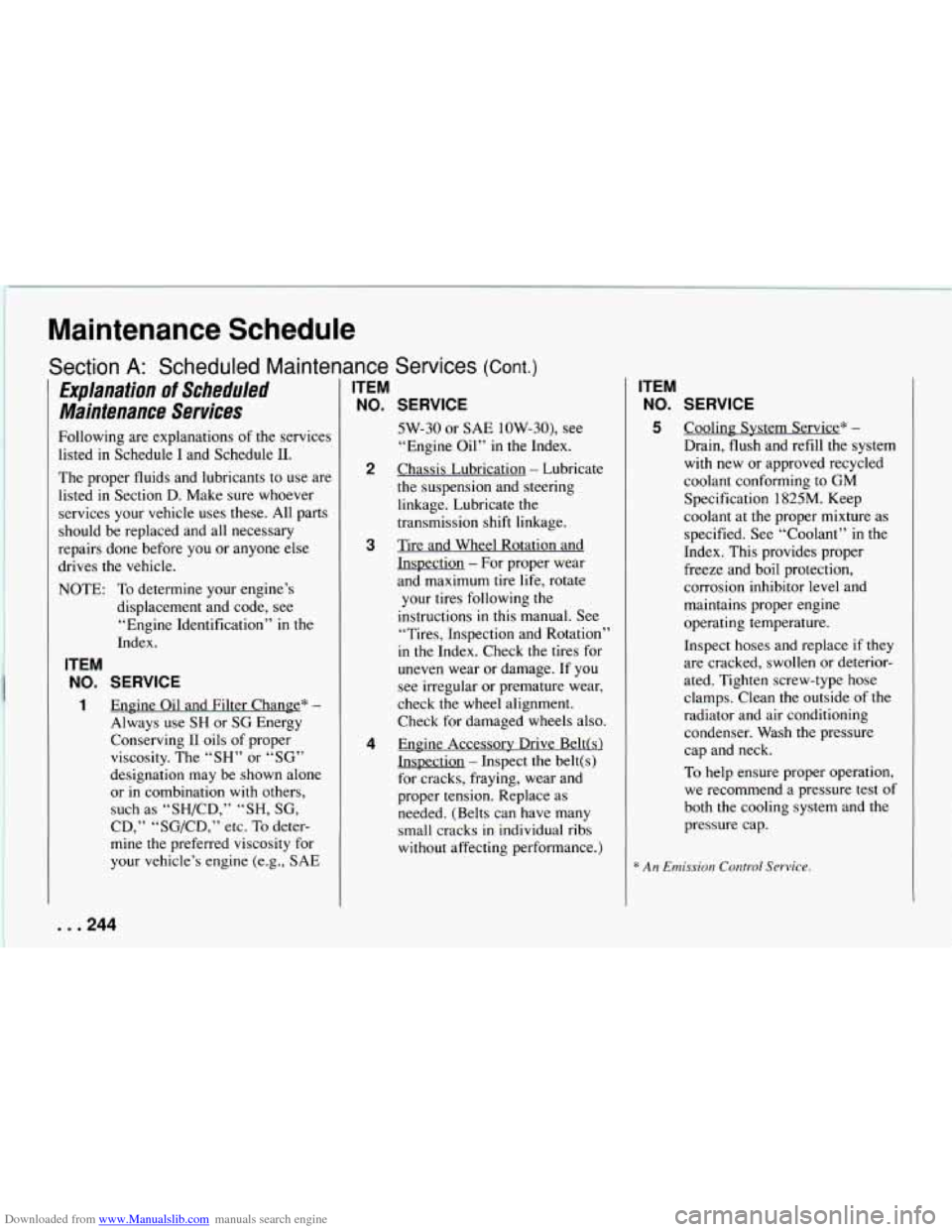
Downloaded from www.Manualslib.com manuals search engine Maintenance Schedule
Section A: Scheduled Maintenance Services (cont.)
Explanation of Scheduled
Maintenance Services
Following are explanations of the services
listed in Schedule
I and Schedule 11.
The proper fluids and lubricants to use are
listed
in Section D. Make sure whoever
services your vehicle uses these. All parts
should be replaced and all necessary
repairs done before you or anyone else
drives the vehicle.
NOTE: To determine your engine’s
displacement and code, see
“Engine Identification”
in the
Index.
ITEM
NO. SERVICE
1 Engine Oil and Filter Change” -
Always use SH or SG Energy
Conserving I1 oils of proper
viscosity. The
“SH” or “SG”
designation may be shown alone
or
in combination with others,
such as “SH/CD,”
“SH, SG,
CD,” “SG/CD,” etc. To deter-
mine the preferred viscosity for
your vehicle’s engine (e.g., SAE
ITEM
NO.
2
3
4
SERVICE
5W-30 or SAE 1OW-30)’ see
“Engine Oil”
in the Index.
Chassis Lubrication
- Lubricate
the suspension and steering
linkage. Lubricate the
transmission shift linkage.
Tire and Wheel Rotation and
InsDection
- For proper wear
and maximum tire life, rotate
your tires following the
instructions
in this manual. See
“Tires, Inspection and Rotation”
in the Index. Check the tires for
uneven wear or damage. If you
see irregular or premature wear,
check the wheel alignment.
Check for damaged wheels also.
Engine Accessory Drive Belt(s)
Inspection
- Inspect the belt(s)
for cracks, fraying, wear and
proper tension. Replace as needed. (Belts can have many
small cracks
in individual ribs
without affecting performance.)
ITEM
NO. SERVICE
5 Cooling System Service* -
Drain, flush and refill the system
with new or approved recycled
coolant conforming to
GM
Specification 1825M. Keep
coolant at the proper mixture as
specified. See “Coolant”
in the
Index. This provides proper
freeze and boil protection,
corrosion inhibitor level and
maintains proper engine
operating temperature.
Inspect hoses and replace
if they
are cracked, swollen or deterior-
ated. Tighten screw-type hose
clamps. Clean the outside
of the
radiator and air conditioning
condenser. Wash the pressure
cap and neck.
To help ensure proper operation,
we recommend a pressure test of
both the cooling system and the
pressure cap.
* An Emission Control Service.
. . .244
Page 247 of 292

Downloaded from www.Manualslib.com manuals search engine ITEM
NO. SERVICE
6 Transmission Service - For
manual transmissions, fluid
doesn’t require changing. See “Periodic Maintenance
Inspections.”
For automatic transmissions, change both
the fluid and filter
every 15,000 miles (25
000 km)
if the vehicle is mainly driven
under one or more of these
conditions:
In heavy city traffic where the
outside temperature regularly
reaches
90°F (32°C) or
higher.
In hilly or mountainous
terrain.
When doing frequent trailer
towing.
Uses such as found in taxi,
police car or delivery service.
If
you do not use your vehicle
under any
of these conditions,
change both
the fluid and
filter every
100,000 miles
(166 000 km).
ITEM
NO.
7
8
9
10
SERVICE
Spark Plug Replacement* -
Replace spark plugs with the
proper type. See “Replacement
Parts” in the Index.
Spark Plug Wire Inspection*?
-
Inspect for burns, cracks or other
damage. Check the boot
fit at the
distributor and at the spark plugs.
Replace wires as needed.
Air Cleaner Filter Replacement*
- Replace every 30,000 miles
(50 000 km) or more often under
dusty conditions. Ask your
dealer for the proper replacement
intervals for your driving
conditions.
Fuel Tank. Cap and Lines
Inspection”?
- Inspect fuel tank,
cap and lines (including fuel rails
and injection assembly) for
damage or leaks. Inspect fuel cap
gasket for an even filler neck
imprint or any damage. Replace
parts as needed. Periodic
replacement of the fuel filter is
not required.
ITEM
NO. SERVICE
11 Rear Axle Fluid Change - If your
vehicle is used to pull
a trailer,
have the rear axle gear lubricant
changed every
7,500 miles
(12
500 km).
If your vehicle is not used
to pull
a trailer, but has a limited-slip
differential, have the rear axle
gear lubricant changed once after
the first
7,500 miles (12 500 km).
* An Emission Control Service.
t The US. Environmental Protection Agency
or the California Air Resources Board has
determined that the failure to pegorm this
maintenance item will not nullify the emission
warranty or limit recall liability prior to the
completion of vehicle useful life. General
Motors, however, urges that all recommended
maintenance services be performed at the
indicated intervals and the maintenance be
recorded in “Section
E: Maintenance Record.”
245.. .
Page 248 of 292
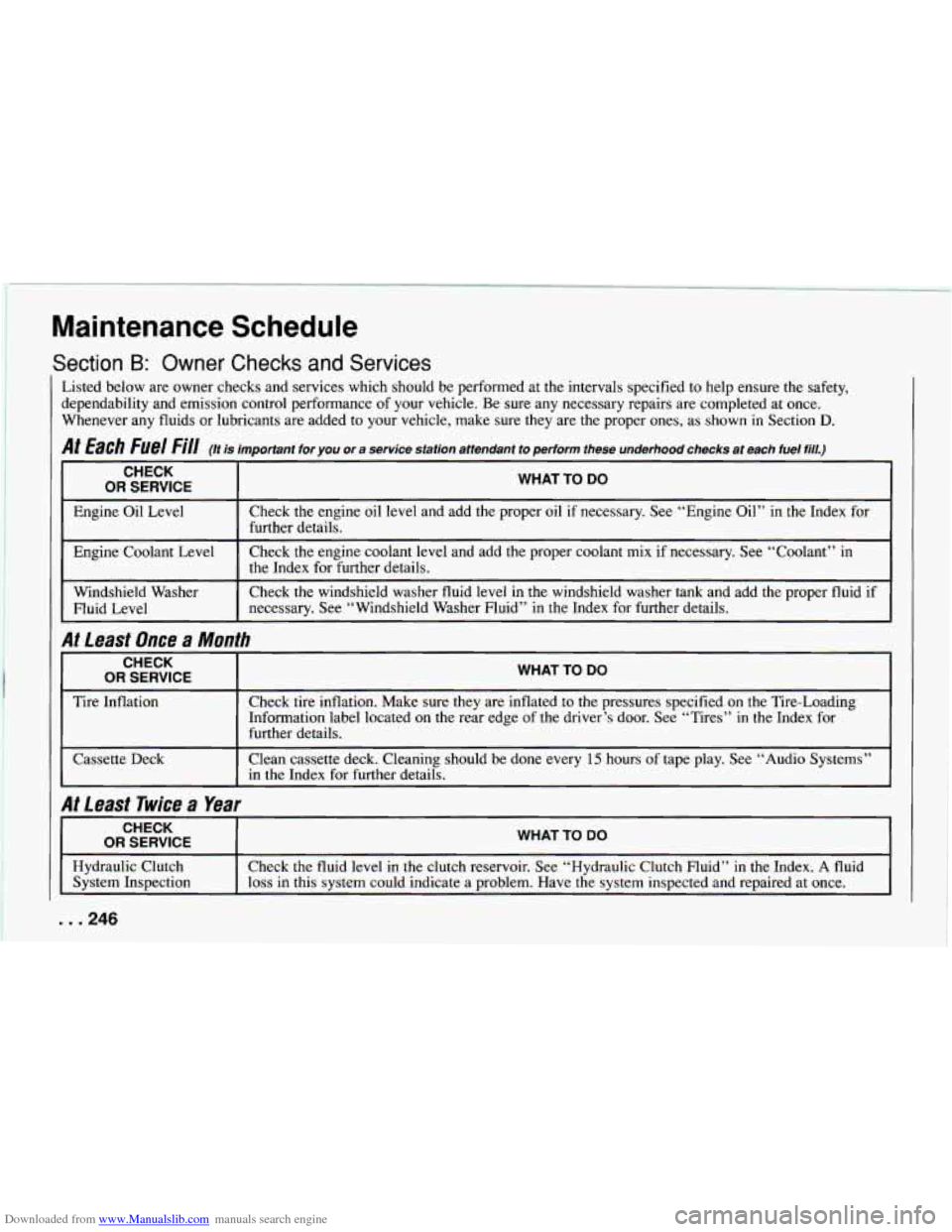
Downloaded from www.Manualslib.com manuals search engine Maintenance Schedule
Section B: Owner Checks and Services
Listed below are owner checks and services which should be performed at the intervals specified to help ensure the safety,
dependability and emission control performance of your vehicle. Be sure any necessary repairs are completed at once.
Whenever any fluids or lubricants are added to your vehicle, make sure they are the proper ones, as shown in Section
D.
At Each Fuel Fill (It is important for you or a service station attendant to perform these underhood checks at each fuel fill.)
CHECK
OR SERVICE WHAT TO DO
Engine
Oil Level
Check the engine coolant level and add the proper coolant mix if necessary. See “Coolant” in
Engine Coolant Level Check the engine
oil level and add the proper oil if necessary. See “Engine Oil” in the Index for
Check the windshield washer fluid level
in the windshield washer tank and add the proper fluid if
Windshield Washer
Fluid Level necessary. See “Windshield
Washer Fluid”
in the Index for further details.
further details.
the Index for further details.
At Least Once
a Month
CHECK
OR SERVICE WHAT TO DO
Tire Inflation
Check tire inflation.
Make sure they are inflated to the pressures specified on the Tire-Loading
Information label located on the rear edge of the driver’s door. See “Tires” in the Index for
further details.
Cassette Deck Clean cassette deck. Cleaning should
be done every
15 hours of tape play. See “Audio Systems”
in the Index for further details.
At Least Twice a Year
CHECK
I OR SERVICE
I
Hydraulic Clutch
System Inspection
WHAT TO DO I
Check the fluid level in the clutch reservoir. See “Hydraulic Clutch Fluid” in the Index. A fluid
loss
in this system could indicate a problem. Have the system inspected and repaired at once.
. . .246
Page 249 of 292
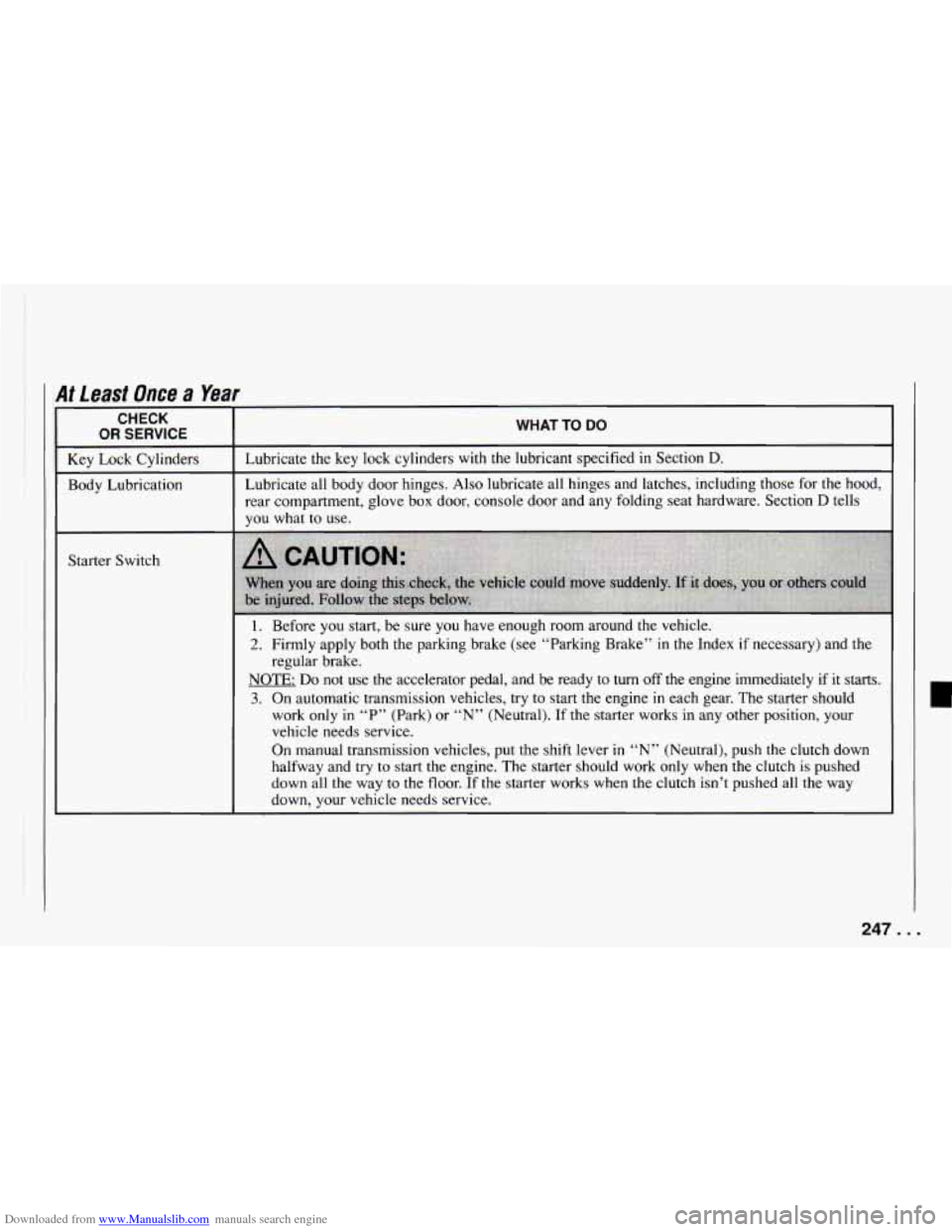
Downloaded from www.Manualslib.com manuals search engine At Least Once a Year
CHECK
OR SERVICE
r
Starter Switch
WHAT TO DO
Lubricate the key lock cylinders with the lubricant specifiedin Section D.
Lubricate all body door hinges. Also lubricate all hinges and latches, including those for the hood,
rear compartment, glove box door, console door and any folding seat hardware. Section
D tells
you what to use.
1. Before you start, be sure you have enough room around the vehicle.
2. Firmly apply both the parking brake (see “Parking Brake” in the Index if necessary) and the
NOTE:
Do not use the accelerator pedal, and be ready to turn off the engine immediately if it starts.
3. On automatic transmission vehicles, try to start the engine in each gear. The starter should
work only in
“P” (Park) or “N” (Neutral). If the starter works in any other position, your
vehicle needs service.
On manual transmission vehicles, put the shift lever
in “N” (Neutral), push the clutch down
halfway and try to start the engine. The starter should work only when the clutch is pushed
down all the way to the floor. If the starter works when the clutch isn’t pushed all the way
down, your vehicle needs service.
regular brake.
247. . .
Page 250 of 292
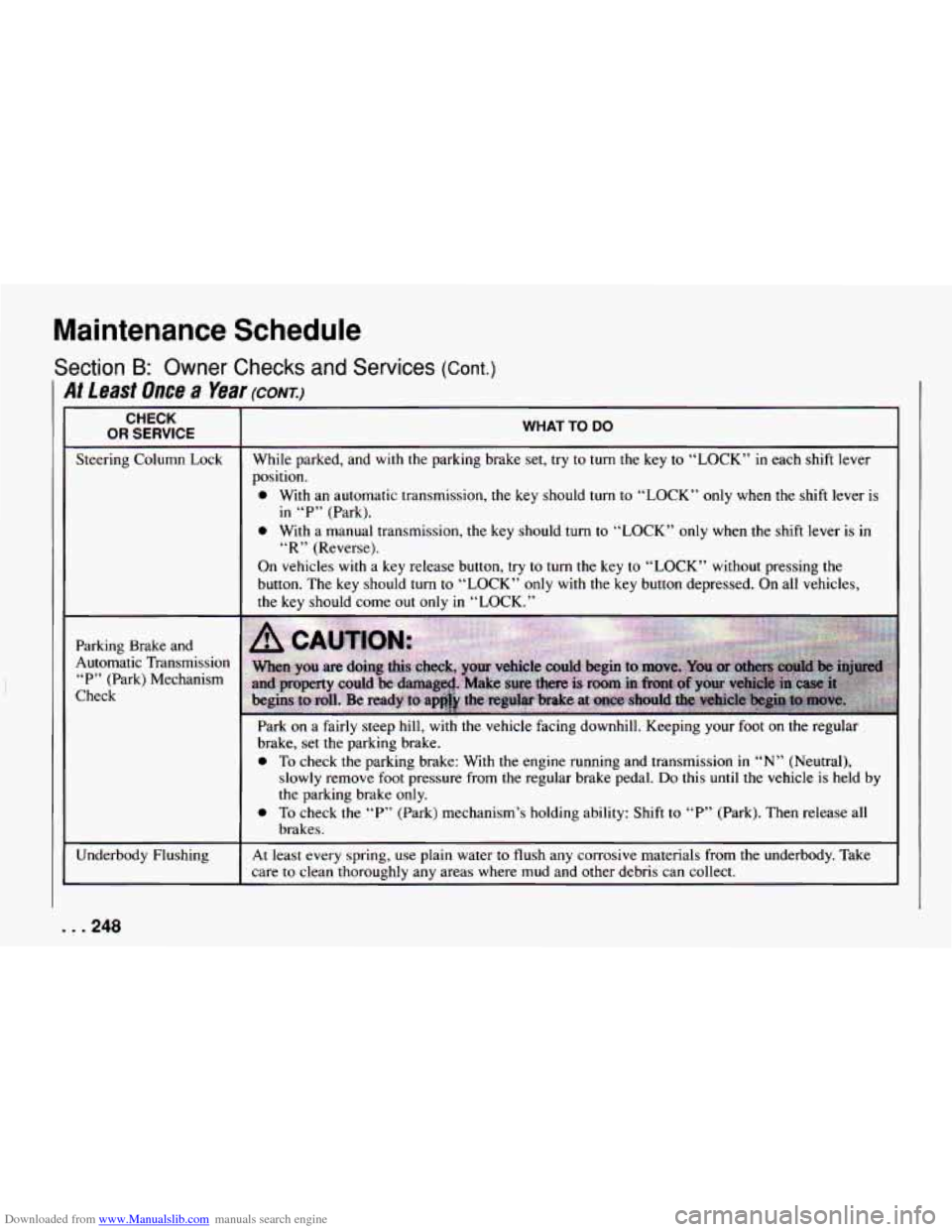
Downloaded from www.Manualslib.com manuals search engine Maintenance Schedule
Section B: Owner Checks and Services (Cont.)
At Least Once a Year (CONT.)
CHECK
OR SERVICE
Steering Column Lock
Parking Brake and
Automatic Transmission “P” (Park) Mechanism
Check
Underbody Flushing
WHAT TO DO
While parked, and with the parking brake set, try to turn the key to “LOCK” in each shift lever
position.
0 With an automatic transmission, the key should turn to “LOCK” only when the shift lever is
0 With a manual transmission, the key should turn to “LOCK” only when the shift lever is in
On vehicles
with a key release button, try to turn the key to “LOCK” without pressing the
button. The key should turn to “LOCK” only with the key button depressed. On all vehicles,
the
key should come out only in “LOCK.”
in “P” (Park).
“R” (Reverse).
Park on a fairly steep hill, with the vehicle facing downhill. Keeping your foot on the regular
brake, set the parking brake.
0 To check the parking brake: With the engine running and transmission in “N” (Neutral),
slowly remove foot pressure from the regular brake pedal.
Do this until the vehicle is held by
the parking brake only.
brakes.
0 To check the “P” (Park) mechanism’s holding ability: Shift to “P” (Park). Then release all
At least every spring, use plain water to flush any corrosive materials from the underbody. Take
care to clean thoroughly any areas where mud and other debris can collect.
. . .248